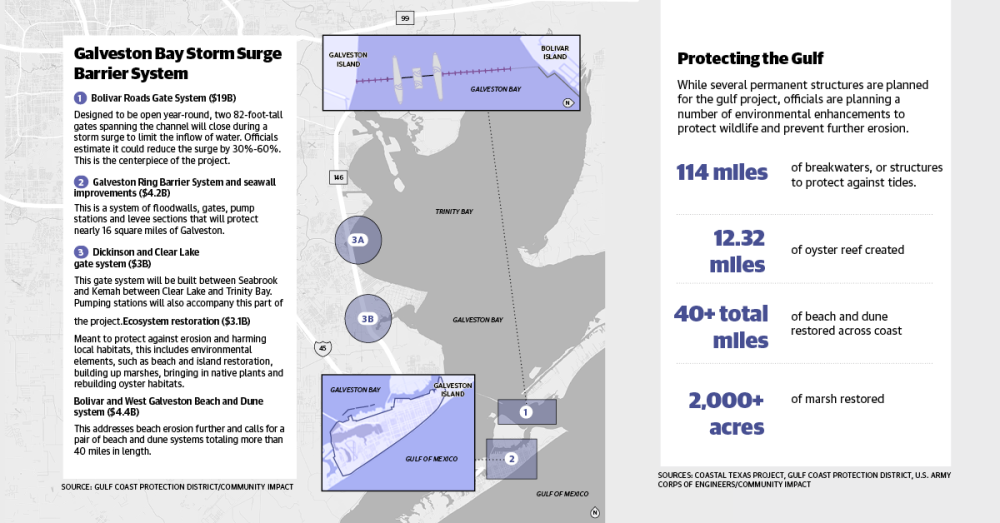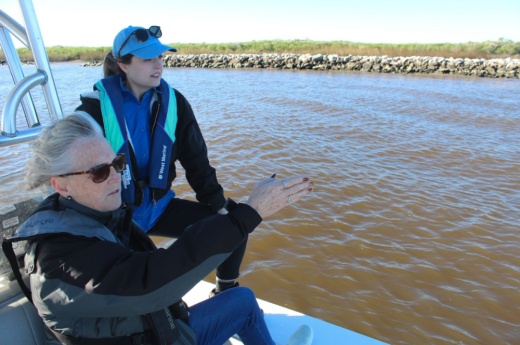The project will include a number of components that could protect the coast against storms and hurricanes, according to documents from the Gulf Coast Protection District, or GCPD.
Construction, however, has yet to start, and officials with the various agencies associated with the project, which runs down the Texas coast, believe it could take a couple more years for work to begin.
Lack of funding, particularly from the federal government, has been the key challenge in starting the project, former GCPD Executive Director Nicole Sunstrum said. Despite this, she said some developments from 2024 could help things move forward.
“It can be frustrating that we don’t see more action on the federal side, but the size of this project is unprecedented,” Sunstrum said.
The overview
In May, the Army Civil Works Program Fiscal Year 2024 Work Plan allocated $500,000 for preconstruction and design of the first segment of work for the Coastal Texas Project at Bolivar Peninsula and the Galveston Bay.
This slate of improvements, also called the Galveston Bay Storm Surge Barrier System, or the “Ike Dike,” will include components that could help defend both the bay and the Gulf in the Galveston area, according to GCPD documents.
The system is part of more than a dozen projects that could line the Texas coast from Galveston to South Padre Island, according to documents from the project’s website.
All the projects in their totality will cost around $34 billion, with the Galveston-area projects taking up the bulk of funds, Sunstrum said.
The $500,000, which will be used to design the ecosystem restoration portions of the project, could open it up to additional funding, said Kelly Burks-Copes, project manager for the U.S. Army Corps of Engineers.
“It’s not necessarily the amount of money but ... more about where it puts you in the process,” said Sunstrum, who left the GCPD on Nov. 15.
Despite this, officials said they’re waiting on the federal government to help with said funding. Once that funding does come through, project documents show it could take more than a decade to build the system, which Sunstrum and others have called the largest infrastructure project in the history of the United States.
Texas House Rep. Dennis Paul, R-Clear Lake, said the goal is to build it before another major storm hits.
“Sitting around waiting for Washington to act after an event is not what we want,” Paul said.

Funding is the catalyst to all the projects being pitched for the Texas coast. The federal government is on the hook for 65% of the total cost, with the remainder coming from the state and other sponsors, Burks-Copes said.
Among the $34 billion, roughly $27 billion is expected to go to infrastructure for the system, Sunstrum said. While she said the current cost estimation is accurate as of now, the length of the project could be impacted by inflation, which becomes more of a factor the longer the project lingers.
In addition to the $500,000 from the federal government, the state of Texas has provided $226 million in funding, Sunstrum said.
Despite the project’s cost, officials have defended its need in the form of money saved. Disasters, such as Hurricane Ike, did nearly $29.5 billion in damage, according to data from the Texas General Land Office.
U.S. Rep. Randy Weber, R-Beaumont, said Nov. 13 that he is continuing to push for funding at the federal level, calling the work “critical” to the region. To that end, the federal government’s appropriation process begins at the start of 2025, which could provide an avenue to get more funding. Despite this, Weber did not specify how long he expects it to take to get funding.
“However long it takes, you can count on me to keep pushing hard,” Weber said.
When work starts, timelines from the project’s website suggest the Galveston Bay system could take between 12 and 20 years to build out.

As the project has gone through stages, concerns from some groups, including nonprofit Turtle Island Restoration Network, which is dedicated to protecting marine wildlife, have lingered with it. Ocean Program Director Joanie Steinhaus said she’s worried about the effect the project would have on the Gulf near Galveston. Concerns about erosion and the environmental protections still need to be addressed, she said. Nature-based solutions, such as dredges and things that absorb storm surge, are items she said she would support.
“We need to work with nature,” she said. “We need to stop building and protect what we have. Not allow more construction.”
However, those with the project, including Burks-Copes, point to the number of environmental restoration projects included in the plans.
While several permanent structures are planned for the gulf project, officials are planning a number of environmental enhancements to protect wildlife and prevent further erosion. Some of those include:
- 114 miles of breakwaters, or structures to protect against tides.
- 12.32 miles of oyster reef created
- 40+ total miles of beach and dune restored across coast
- 2,000+ acres of marsh restored
With the next Texas legislative session starting in January, Paul said he’s optimistic the state will pass the Gulf Coast funding account, which would allow extra federal dollars to be deposited and used for future and current Gulf Coast protection projects. It had support from both parties in 2023 but was vetoed due to technicalities, Community Impact previously reported.
At the federal level, Sunstrum said she expects funding to come in some capacity soon. A new presidential administration along with recent hurricanes, such as hurricanes Beryl, Helene and Milton this year, could prompt officials to approve a disaster relief bill, Sunstrum said.
Weber’s office said they weren’t aware if conversations on such a bill have taken place.
Despite delays and hangups with funding, Sunstrum said she remains confident the project will get built due to the safety it would bring to both people and the broader economy.
Paul shared a similar sentiment, calling the project “life changing.”
“I tell people 100 years from now nobody is going to worry about what we’re arguing [about],” he said. “But every Texan will know there’s a coastal barrier that’s protecting their vital region. It’ll be a great legacy for all Texans. ... I’m excited to be a part of it.”






